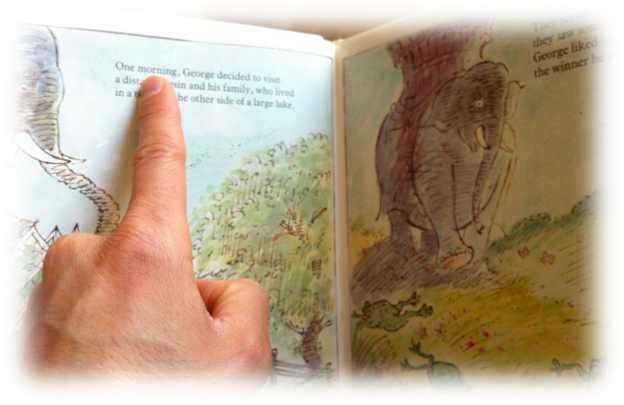Improving children’s literacy through pointing and karaoke style closed captions
My daughter is learning to read and write at school and her teachers have said that she struggles at times and may be a little behind in her literacy.
In an effort to improve her reading and writing skills, I’m obviously spending more time with her practicing writing and reading books, spelling out words and playing I spy.
None of these are easy for my daughter (or me and we’ve had an argument or two about it) and for some reason elephant still starts with an ‘H’…

Two recent discoveries for me around children’s literacy (and reading) I have been attempting to put into practice:
Pointing at the words in children’s books
I may have tweeted or facebooked about this when I discovered the article in April, but recent research by Ohio State university shows that when teachers read story books in class, those that read and point to the words as they read them have children with higher reading skills than those who’s teachers do not point to the words.
The study on preschoolers’ reading sessions in class focussed around two key variables: The number of reading sessions per week and (this is the one that is soooo simple and yet soooo powerful) referencing the text of a story as it was read.
There were 3 groups of children (300 kids spread across 85 different classrooms) with two groups using the text referencing and one group reading without any special training. The two using referencing were then split between those that had 2 reading sessions per week and 4 sessions per week.
Two years later, both groups that used the referencing as part of their reading sessions still had higher reading and literacy skills than the control group!
Needless to say, I’m pointing out precisely which words I’m reading when my daughter and I read a book together.
A niggling doubt
If I’m honest, I worried a little whether pointing out which words I was reading wouldn’t actually help my daughter to learn how to put a word together from it’s constituent parts, but simply teach her what certain words looked like. My concern was that it might help her appear to learn to read in the short term, but may hinder her longer term ability to learn new words.
According to the research findings however, this referencing approach not only helps kids learn to read, but their results showed a stronger understanding of what the meaning behind each sentence and paragraph was.
For me, this is the clincher: If these kids were understanding the the meaning of and behind the words better, it meant that the actual reading element was easier for them, thus giving their brains more resources to think about and make the connections between the individual words.
—
Now, as it turns out, this is actually not new news. Even though it may be in relation to reading books with kids, but research done back in 1991 showed the power of referencing the words with what you were hearing…
Karaoke style closed captions on videos
I came across an interesting site a week or two ago which promotes videos with same language closed caption sub-titles. In English, that means that they’re videos where the sub-titles you see are in the same language as the audio.
BookBox is the name of the site and they come at this idea as a social enterprise helping children in India to improve their literacy by watching cartoons (termed ani-videos by BookBox). Based in India, BookBox (I think) are using their products to help teach literacy (and have ani-videos for 30 different languages!) throughout India and they’ve won a good few awards for their work too!
I’m always a fan of social enterprises, so was delighted to discover these guys doing something awesome around literacy for kids.
Here is one of their videos of a traditional folk story complete with the same-language closed captions in English:
[youtube=http://www.youtube.com/watch?v=wQ3QndKvTvA&rel=0]
As you can see, it’s pretty good stuff, and perfect for teaching kids to read. They even talk about how useful such an approach is when learning a second language, which appeals to myself as I’ve always been envious of those who can so easily converse with the locals when on holiday.
I will certainly be sitting my daughter in front of a couple of BookBox’s videos next time she comes to stay and to see what she thinks of them.
Checkout their own “About BookBox” video to find out more and support these guys!
[youtube=http://www.youtube.com/watch?v=u4KodLXEuP0&rel=0]
Closed Captions on TV programs for kids
The great thing here as well is that in the UK, all children’s television programs have closed captions for those kids who are deaf.
So now, not only can I read children’s story books with my daughter while using my finger to point to the words as I read them, but for the couple of hours a day she’s allowed to watch tv (I don’t let her watch more than that if I can help it) I’ll turn on the closed captions for the program as well!
I’ll have her reading Great Expectations by the time she’s 6 😉